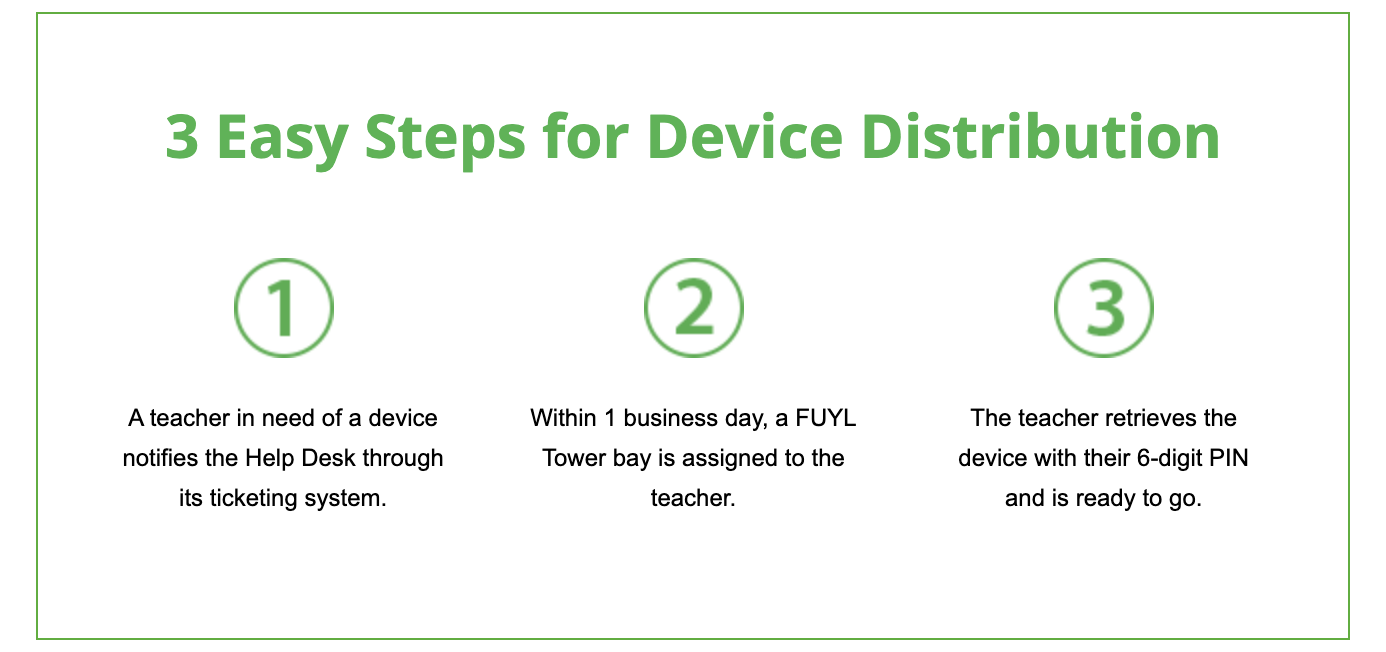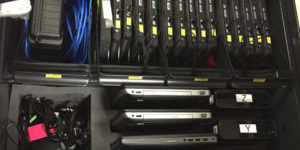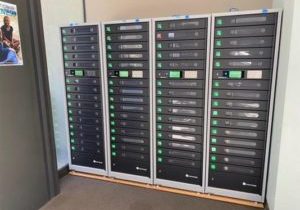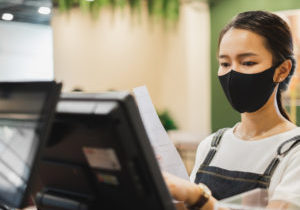Baskets are Good for Business
There’s a reason why baskets have been around for centuries. From babies to bread, our prehistoric ancestors understood how useful baskets are for carrying, storing and transporting just about anything. Sometimes the simplest solution is the best.
Baskets for Deploying Mobile Devices
Thousands of years later, we’re still using baskets to transport our groceries and store our laundry. Just as baskets help make chores and shopping faster and more efficient, it turns out baskets are good for business too! Whether you’re offering in-person training, managing a distribution center or facilitating vaccinations, if your operational process includes sharing devices, our Basket system provides multiple benefits. LocknCharge slotted device Baskets enable hand-out and pack-up of devices in less time, giving you more time to focus on operational goals.
Top 5 Ways Baskets Benefit Business
Distribute Devices in a Matter of Seconds
“We have limited time with the participants, so being able to grab a smart device Basket and placing them on a table give participants immediate access to the devices. I can do that in a matter of seconds which meets our need tremendously.”
- Gene Howell, Manager for Educational Technology at Australian Institute of Management in Western Australia.
The Australian Institute of Management in Western Australia (AIM WA) is dedicated to building leadership and management capability. Their suite of training courses attracts over 20,000 participants each year. Most classes require each participant to have immediate access to technology. There’s no time to waste distributing shared devices.
Slotted device charging Baskets by LocknCharge make device deployments more efficient, allowing for quick distribution and collection by the trainer. At AIM WA, iPads are stored and charged in Carrier 30 Carts in Baskets of five. When it’s time to set up for each class, the trainer slides open the secure Cart lid, takes out a couple of Baskets, and places them on tables for each participant to grab. Participants no longer have to wait in line then take out a device one by one as they would with a traditional cabinet-style laptop cart. When students start learning immediately vs. lining up, 70 hours of class time is saved per year.
Reloading the Cart is a simple three-step process:
Step 1: Put devices back into technology Baskets with their charging ports facing up
Step 2: Place Baskets into the Cart
Step 3: Plug charging cords into the devices
Cords that stay in the Cart dramatically reduces the number of broken, misplaced and stolen cords. In addition, Carts can be easily wheeled between classrooms to safely and quickly distribute devices where they’re needed most.
Facilitate Healthcare on the Go
The COVID-19 pandemic is driving demand for healthcare providers to go on the road to facilitate healthcare. Where there’s a testing and immunization event in the field or a mobile health clinic, there’s a need for devices and a way to charge, store and secure them.
FEMA’s Community Vaccination Centers Playbook recommends 100 iPads for facilities distributing up to 6,000 vaccination doses a day. These devices can be used for patient registration, scheduling and clinical documentation. At COVID-19 testing stations, staff members can also use iPads to scan patients’ insurance information quickly.
Whether sharing a hundred devices or a dozen, Baskets are an efficient method to speed up device deployment. At the start of the day, a worker grabs the Baskets from a secure Carrier Cart and sets them out to be easily accessed by the nursing teams. During their shifts, nurses return devices to the Baskets as a centralized, safe place to store them when not in use. At night, all devices are placed in Baskets which are then placed into Carts for charging.
Because baskets are removable, Carrier Carts offer an open-concept that adapts for healthcare providers on the road—making them the ideal solution for mobile blood banks and clinics. The fleet of vans operated by the Community Blood Center (CBC) travels throughout Kansas and Missouri fully stocked with everything necessary for a blood donation procedure. When each van moves multiple laptops, tablets, keyboards, wireless printers, webcams, and all of their power supplies, the task can be pretty daunting.
The blood bank needed a “mobile device kit” that could easily charge, store, secure and transport a wide variety of mobile devices and all necessary power supplies. They found success in the LocknCharge Carrier 40 Cart. Because of the open-concept design, they removed half of the Baskets and retrofitted their own padding and shelf to accommodate their unique needs.
Read the Mobile Blood Bank Case Study
Community Blood Center of KC Goes Mobile with Blood Bank and Devices
Over the past 60 years, the Community Blood Center (CBC)…
Read MoreSchedule a Live Product Demo
Schedule a live video demo with a LocknCharge team member to get a closer look at how our products help make your life easier.
Little Friends Plans for Return to In-Person Schooling
Warrenville, IL
Background

Since 1965, the Little Friends® non-profit agency has been fulfilling lives regardless of challenge. Their groundbreaking programs empower people of all ages experiencing autism and other intellectual and developmental disabilities to live, learn, work and thrive in their communities.
Not long ago, Little Friends moved to a new facility and can now provide more programming to the growing needs of those they serve.
Challenge
Variety of Devices Needs
The organization prides itself on providing programs for people of all ages, from toddlers to seniors–so it’s no surprise that device needs vary. Staff use mobile devices for record keeping, while teachers have laptops. iPads are available in Pre-K to 3rd-grade classrooms, and 4th graders and up are assigned Chromebooks. Various technology needs resulted in the need for a flexible solution to store, charge and lock many device types.
Smaller Class Sizes
Because class sizes are small with a max of 8 students per classroom, selecting compact charging solutions was key. Products that are easily accessible and fit well in the daily routine for both staff and students were an essential requirement.
Solution
Like the comprehensive plan Little Friends creates for each child, they also needed a comprehensive strategy for charging, storing and securing shared iPad devices. Having worked with LocknCharge before, Mike Briggs, President & CEO of Little Friends, was very familiar with LocknCharge solutions. He made what he referred to as an “easy decision” to purchase 25 Carrier™ 10 Charging Stations.
Wall-Mountable Carrier Charging Stations
Compact
These compact charging stations look great and don’t occupy floor or counter space when mounted to a wall.
Reliable
Carrier 10 easily does the job it’s supposed to do–charging, storing and securing devices. Cables and charging supplies stay organized in a separate compartment, allowing for quick plug-in after each use.
Flexible
With eight students max per class, a smaller charging station with a lower capacity met the needs of their 1:1 program.
Compatible
Carrier Stations are universal, meaning they work with most devices–including iPads, Chromebooks, laptops and tablets–which can be deployed with ease using Baskets.
What’s Next?
With grants, Little Friends will continue to invest in state-of-the-art technology, including robots to assist children with speech therapy. They’re committed to creating tech champions who explore innovative digital technology. The leadership team at Little Friends understands that these investments bring an incredible opportunity to incorporate new methods of teaching and learning.
7 Surprising Lessons We Learned During the Pandemic

What a year it’s been. At the start of the pandemic, we scrambled to find the time to navigate a work from home world. We filled our days with setting up remote offices and the seamlessly unending homeschooling challenges while trying our best to keep our families fed and our kids entertained. After shifting gears and getting ourselves headed in the right direction, we have more time on our hands. We’ve gotten the hang of this whole Zoom thing, and we’re making good use of the hours we used to sit in traffic.
We won’t deny that we were a bit overwhelmed at first. But now that we’ve caught our breath, we can step back and reflect on the many positives that came out of the chaos. With some perspective, we understand that the hectic times helped us boil down what’s important and take risks we may never have taken otherwise. Most of all, we’ve realized how grateful we are for our personal and professional connections. Despite the physical distance, we’ve struggled and innovated, scrambled and prioritized, and cried and laughed—together. Now more than ever, we know our strength lies in our community.
Our team recently got together to review what we’ve learned over the past twelve months. We want to share with you a few of the surprising lessons that emerged from our discussion.
1. Nothing Can Replace a Face-to-Face Visit
In other words, we sure do miss you! In “normal” times, our schedules are packed with tradeshows and customer visits. The pandemic has taught us that every frenzied second spent planning these events and traveling around the world is well worth it.
While we’ve adapted with online meetings, video demos and instructional webinars, we’ve discovered that something is missing. And that something is the spectacular spontaneous collaboration that happens when we’re face-to-face with friends, customers and partners.
There’s no replacement for chilling and charging with thousands of imaginative educators at ISTE or healthcare heroes at HETT. In-person interactions at shows like these are where we’ve gotten many of our big ideas. At one past BETT show, customers told us how our Joey Cart could be enhanced. Based on their comments, we completely remodeled this multi-device charging station was with the end-user in mind. When we met with our long-time customer and partner, Putnam City Schools, we came away with their idea for the perfect product on the back of a napkin!
2. Educators and Schools are Invaluable
While we knew this long before COVID, this past year has reinforced that teachers, faculty and support staff are invaluable. Educators worldwide stepped up to teach us that “school” isn’t a building. Many of us experienced first-hand what it’s like to be a teacher. We’ll let our kids tell you just how that went.
***SPOILER ALERT***
Let’s just say the #SchoolofLock made us even more thankful for superstar educators around the world!
3. Digital Transformation Went From Planning for the Future to RIGHT NOW
97% of executives say COVID-19 sped up digital transformation making it the digital accelerant of the decade. Check out these excellent examples of how both schools and organizations have risen to the occasion, innovating and making lemonade out of lemons.
To meet the exponential increase in traffic at drive-throughs caused by indoor dining closures, many fast-food and fast-casual restaurants have deployed hand-held devices to speed up the ordering process. One LocknCharge customer now moves 200 cars through their drive-through per hour when they equipped their employees with iPads charged and secured with Putnam Charging Stations.
At the start of the pandemic, the San Francisco USD Department of Technology quickly developed a plan for the safe and successful deployment of devices to nearly 5,000 educators. As part of this plan, SFUSD strategically placed four LocknCharge FUYL Tower Smart Lockers at the district’s centrally-located main office, where they could be accessed beyond regular office hours and even on weekends. Each bay is equipped with one ready-to-go device, which simplified the process of distributing and maintaining devices to three easy steps without the need for any face-to-face interaction or Help Desk interruption.

4. Who You Buy from Matters as Much as What You Buy
The 9-5 workday is obsolete. If an emergency happens, or you need support outside of what were once regular business hours, customer service and tech support must be available. The past year has highlighted the importance of partners over vendors who stand by you through tough times. Great partners commit to keeping projects on track and go above and beyond to provide the best outcome.
With tight budgets only getting tighter, great partners also ensure that your investment will be a good one for many years to come, offering future-proof products backed with a lifetime warranty.
5. The Use of Technology Kept Our Relationships Going
While nothing can substitute face-to-face meetings and human touch, the reality is that many of those interactions aren’t possible during a pandemic. Thankfully, technology has served as a vital link connecting teachers with students, doctors with patients and coworkers with each other. The frontline healthcare workers at the University of California, San Francisco School of Medicine also found that technology helps ease hospitalized patients’ discomfort.
After witnessing patients struggling while separated from loved ones, the resident physicians and medical students asked for donations of tablets to facilitate video conferences with family and friends. Through the #ConnectingThroughCovid initiative, countless expressions of love and prayers have been shared, easing loneliness and positively affecting lives.
6. Preparation Coupled with Flexibility is Key
If there’s one thing we’ve learned from the past year, it’s that there’s no way to predict the future. However, you can pivot more quickly and smoothly with the right preparation and a willingness to adapt.
With a district-wide commitment to technology and a future-proofed tech plan, Chicago’s Arbor Park School District was well positioned with the sudden shift to remote learning.
In the past two years, Arbor Park made a complete shift from shared desktop computers and mobile devices to a 1:1 program. After rigorous research and setting up a forward-thinking infrastructure, they moved quickly, which has helped acclimate students and staff at an even pace with little pushback. According to David Termunde, the Chief Technology Officer, “the extensive teacher training and professional development on new devices and platforms has certainly paid off during COVID-19.”
In just minutes, they also tweaked their smart locker workflow to enable a no-contact pickup location for replacement devices. Just like an Amazon locker, a FUYL Tower was relocated to a publicly-accessible location within the school. Parents place orders from the district’s ecommerce site. The school then fulfills the order by placing it in a FUYL Tower compartment. Parents follow simple email instructions to unlock and pick up their requests from their assigned FUYL Tower locker number.
7. Hand AND Device Hygiene is Critical to our Well-Being
We’ve known for a while that you can help yourself and those around you stay healthy by washing your hands often. With the hoarding of cleaning supplies at the start of the pandemic, it became abundantly clear that another critical step towards good hand hygiene is routinely cleaning and sanitizing frequently touched surfaces. Proper sanitization methods of doorknobs, desks, and last but not least, our devices can reduce the risk of spreading germs.
Healthy hand hygiene and device hygiene go hand-in-hand. As germs are spread by users touching devices multiple times a day, sanitizing them more often can prevent cross-contamination.
Schedule a Live Product Demo
Schedule a live video demo with a LocknCharge team member to get a closer look at how our products help make your life easier.
Learn More
San Francisco USD Develops Plan for Successful Device Deployment with Smart Lockers
Learn how SFUSD is using LocknCharge FUYL Towers to streamline safe device distribution for over 5,000 devices.
Read More8 Solutions for Schools to Overcome 1:1 Device Challenges in Schools
Even the most well-established 1:1 device programs in schools can…
Read MoreWebinar: How to Integrate Break/Fix Workflow with FUYL Tower API
Originally Aired: 1/28/21
This webinar covers how to integrate our FUYL Tower Smart Locker and LocknCharge Cloud software into an existing IT infrastructure.
Want to Learn More?
FSTEC Community 2020
iPads in Restaurants: Reducing Costs and Creating Efficient Workflows
The food service industry is based on speed, efficiency and quality to delight their customers. With the growing use of iPads for mobile POS and curbside customer engagement, making sure they are available and charged is becoming a critical part of day-to-day restaurant operations. LocknCharge creates solutions to quickly deploy devices into the hands of those that need them, and efficiently manage the devices when not in use. Our products reduce the burden of managing iPads or other mobile devices, and allow restaurants to focus on serving their customers.
Learn more about how LocknCharge helps restaurants deploy mobile technology on our dedicated restaurant page.







